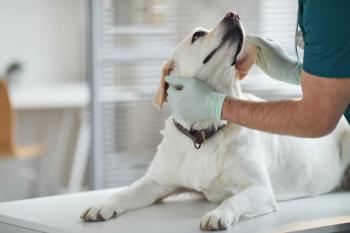
Regulating diabetes mellitus in the dog and cat (Proceedings)
Historically, cats were fed diets higher in insoluble fiber.
Dietary Therapy
Historically, cats were fed diets higher in insoluble fiber. These diets were effective to a certain extent for the same reasons they work in dogs. They slow gastrointestinal transit and subsequent glucose absorption. These diets also enhance weight loss which can decrease insulin resistance in obese cats. Currently, dietary recommendations for cats are for high protein and low carbohydrate. Cats, as carnivores, have decreased hepatic enzyme activity to convert dietary glucose for storage and energy. Cats primarily use amino acids and fat in the diet for energy so carbohydrates are left to contribute more to hyperglycemia. Currently Hills md® and Purina DM® are diets that fit into this category of low carbohydrate, high protein. Initially, kitten diets were also used because of their higher protein content. These diets help reduce postprandial glucose and insulin concentrations, decrease insulin requirements, result in better control of diabetes and can produce remission in some cats. Correction of obesity should also be a goal of dietary therapy and can decrease insulin resistance.
The dog is an omnivore by nature and is more capable of utilizing carbohydrates for energy and storage than the cat. For this reason, dietary recommendations for dogs have focused on minimizing dramatic post-prandial increases in glucose as well as weight control. Diets higher in fiber, particularly soluble fiber, are used and there are many that fit into this category. Again, correction of obesity is also a goal in the dog.
It is important to remember that there is not an ideal diet for all patients. Dogs and cats that are underweight will not tolerate a diet that promotes weight loss so other diets may be necessary.
Oral Hypoglycemics
The majority of the oral hypoglycemics previously used to treat diabetes have fallen out of favor. The sulfonylureas (glipizide, glyburide) were used in cats because their primary mechanism of action is stimulation of insulin production by the pancreas. Cats tend to develop non-insulin dependent diabetes mellitus meaning that they often have some ability to produce endogenous insulin. The idea is that if the pancreas makes more insulin then the diabetes can be controlled. Unfortunately it is now believed that increased stimulation of the pancreatic islets also leads to burn out of the beta cells which can actually result in a decrease of insulin production and progression of diabetes. In addition, amylin is co-secreted with insulin from the beta cells. Amylin becomes amyloid and is deposited in the islets. Islet amyloid has been found in increased amounts in the pancreas of diabetic cats and leads to dysfunction of the islets.
Biguanides, like metformin, do not stimulate insulin production by the pancreas. Instead they enhance sensitivity of the liver and peripheral tissues to insulin. There has been a high incidence of intestinal side effects with this medication at doses necessary to control glucose. Metformin is typically ineffective as a single agent therapy but can help decrease insulin requirements in some diabetic cats that still have detectable levels of insulin.
Acarbose is an alpha-glucosidase inhibitor that affects brush border enzymes in the small intestine decreasing glucose absorption. There has been some success with its use in diabetic cats and dogs. Some cats can be weaned off of insulin. Typically it is administered at 12.5 to 25 mg twice daily in the cat. In the dog, acarbose is started at 25 mg twice daily and increased in 25 mg increments up to 100 mg/dose. Diarrhea may occur in some.
Chromium is a trace element thought to increase tissue sensitivity to insulin. It is believed to be ineffective in the dog and has been inconsistent in the cat. The effects in the cat may be dose dependent with better results at 300 to 600 ppb per day. Vanadium is another trace element that has been shown to have glucose-lowering effects in chemically-induced diabetes in dogs. Vanadium has also been shown to have some glucose lowering effects in diabetic cats.
Intermediate–Acting Insulin
Lente and NPH insulin are classically thought of as intermediate in action. They are the most commonly used maintenance insulin in the dog. Typically they are given twice daily but occasionally dogs are maintained on once daily pork lente insulin (Vetsulin® - Intervet). Pork lente insulin is available in the US as a U-40 preparation. Pork insulin is considered ideal for the dog because the amino acid sequence of porcine and canine insulin is identical. The initial dose of lente insulin for the dog using Vetsulin® is 1 U/kg and if < 10 kg add 1 unit, if 10 – 11 kg add 2 units, if 12 – 20 kg add 3 units and if > 20 kg add 4 units. If giving twice daily, the above dose should be decreased by 50% and given twice daily (about 0.5 U/kg/dose). The initial dose in cats is 0.25 U/kg or 1 to 2 units per cat twice daily.
Neutral Protamine Hagedorn (NPH) must be given to cats and dogs twice daily. The peak is often too rapid and duration too short in both species for once daily administration. Unfortunately this is often the case with twice daily administration, particularly in cats, so this insulin is not routinely used in this species. Human recombinant NPH insulin is available (Novolin N®, Humulin N®) and the initial dose in dogs is 0.25 to 0.5 U/kg twice daily. Cats are initially given 1 to 2 units per cat or 0.25 U/kg twice daily.
Long–Acting Insulin
Protamine zinc insulin(PZI) is primarily used in cats. This insulin was unavailable for several years but is now commercially available as a beef/pork (PZI VET® - IDEXX) and a pure beef (compounding pharmacies) formulation. There are concerns that dogs will develop antibodies against the beef component of this insulin so it is not routinely recommended in this species. The majority of cats can not be regulated on once daily PZI so the initial recommended dose is 0.22 – 0.66 U/kg BID or 1 to 2 units per cat. This is a U-40 insulin so special syringes are required.
Insulin glargine (Lantus® - Aventis Pharmaceuticals) and detemir (Levemir® - Novo Nordisk) are ultra-long acting insulins that were developed to replace human recombinant products in man. Dogs have showed an unpredictable and poor response to glargine so its use is not commonly recommended. Glargine has become increasingly popular in cats with diabetes due to increased rates of diabetic remission compared to lente and PZI insulin, particularly in newly diagnosed diabetic cats. There is evidence to suggest that twice daily administration of glargine prolongs duration, provides better overall glycemic control and improves remission rates. The initial dose recommendations in cats are 0.5 U/kg if glucose is ≥ 360 mg/dL and 0.25 U/kg if glucose is < 360 mg/dL. Because hypoglycemia is fairly common when instituting therapy, glucose curves (pre insulin then every 4 hours) can be done for the first 72 hours when instituting therapy. If hypoglycemia is measured but clinical signs not observed, the dose is reduced by 0.5 to 1 U. If clinical signs of hypoglycemia are observed (extremely rare) the dose is reduced by 50%. The recommended dose in dogs is 0.25 U/kg twice daily. Glargine can be stored in the refrigerator for 6 months after it is opened. Additional information on insulin glargine can be found at
Monitoring
Diabetic monitoring includes evaluation of historical and physical parameters as well as blood glucose. Blood glucose monitoring consists of glucose curves and serum fructosamine levels. Glucose curves can be determined by blood or interstitial glucose concentrations. Interstitial glucose monitors require placement of a probe within the subcutaneous space. The probe then attaches to a recording device that reports glucose every 5 minutes. This device can be in place for several days. Glucose curves were traditionally recommended in poorly regulated diabetics but have become less popular in recent years. Glucose curves performed at home have the advantage of being less likely to be affected by stress hyperglycemia (primarily a problem in cats) that can occur in the hospital environment. Unfortunately there has been day-to-day variability seen in glucose curves obtained at home in dogs. Classically, a pre-insulin glucose followed by glucose measurement every two hours for 12 to 24 hours (depending on frequency of administration) is recommended. Glucose curves are done on poorly regulated diabetics and new diabetics until they are well-regulated. Whether or not they are well-regulated should be based on their clinical signs and less on their glucose curve. An exception is the dog or cat showing low normal to low blood glucose. In this case, adjustments in insulin should be made in any animal with hypoglycemia and animals with low normal glucose should be monitored carefully as Somogyi may be occurring. Curves can be done every 1 to 2 weeks but remember many dogs and cats can take weeks to months for their diabetes to stabilize. Important in cats is also the phenomenon of transient diabetes which is most common in recently diagnosed diabetic cats. These cats may wax and wane in their dependency on insulin. Fructosamine can also be evaluated and may eliminate the effects of stress hyperglycemia on the glucose curve.
Poor Regulation of Diabetes Mellitus
The most common problems observed in uncontrolled diabetics are short duration of insulin effect, Somogyi phenomenon, poor absorption of insulin and concurrent insulin-antagonistic disorders. Most dogs and cats take weeks to months for their diabetes to stabilize so control within the first few weeks is unlikely. Short duration is more common with the intermediate-acting insulin, especially NPH, because they are potent insulins that often reach their nadir within a few hours and return to baseline in less than 10 hours. This is typically not a problem with the pork lente formulation when given twice daily, in fact it's duration is often greater than 12 hours in dogs. Short duration is often a complication with once daily insulin administration. Short duration is addressed by switching to a longer-acting formulation or increasing frequency of administration.
The Somogyi phenomenon is an attempt by the body to regulate glucose in the face of life-threatening hypoglycemia (typically less than 65 mg/dL). When blood glucose is this low epinephrine, cortisol, glucagon and growth hormone are produced in an attempt to bring the blood glucose up. The result is a dramatic increase in glucose often in the 400 to 500 mg/dL range. It can take several days for glucose to return to normal with insulin administration because insulin resistance occurs with hyperglycemia. A curve might suggest the animal is not receiving enough insulin when, in fact, they are receiving too much. An additional complicating factor is that the signs of hyperglycemia (PU/PD, PP, weight loss) can predominate over signs of hypoglycemia (lethargy, anorexia, vomiting). This emphasizes the importance of the glucose curve in animals with poorly regulated diabetes. It is also important to note that this is one instance when spot glucose checks can dramatically affect decision making and not necessarily for the better. Somogyi can occur with intermediate insulin due to potency but can also occur with long-acting insulin due to a wrap around, or 'accumulating', phenomenon. With Somogyi or hypoglycemia, insulin dose should be reduced by 50% or if on particularly high doses (> 2 U/kg/dose) you may want to start over with the initial dose recommendations for that particular insulin.
Poor absorption was primarily a problem with human recombinant ultralente insulin which is no longer available. It appears to be less of a problem with the insulin discussed above. Poor absorption could result in slow absorption and thus a delayed onset and prolonged activity. Decreases in glucose may be present but minimal despite what should be an adequate dose. Absorption problems can be difficult to differentiate from insulin resistance. Typically the type of insulin is switched.
The most common causes of insulin antagonism in the dog are insulin antagonistic medications (e.g. glucocorticoids), obesity, chronic infection (particularly oral, urinary), hyperadrenocorticism and hypothyroidism. The most common disorders in the cat are medications, obesity, hyperthyroidism, pancreatitis and chronic infection (oral disease, urinary tract). Acromegaly and hyperadrenocorticism are rare causes of insulin resistance in the cat. Diseases in other systems can also cause resistance. Insulin resistance should be suspected in cats and dogs that are receiving > 2 U/kg/dose to control signs or those that are not well-controlled on this dose. Insulin antagonism is also suspected in a previously well-regulated diabetic that develops clinical signs and hyperglycemia (once problems with exogenous insulin are ruled out).
Insulin may also be affected by storage, handling and improper administration. Insulin antibodies do not appear to contribute greatly to insulin resistance in the dog and cat. Insulin antibodies were more problematic in beef and beef/pork insulin administered to dogs and this is why PZI is not routinely used in this species
Complications of Insulin Therapy
Persistence of clinical signs is common with insulin therapy. This may be a result of problems with the insulin itself, insulin under dosage, insulin over dosage or insulin resistance.
Insulin may be ineffective if it is stored, handled or administered incorrectly. Unused insulin is typically refrigerated. Once opened, it is often stored at room temperature when used in man. This led to the recommendation that insulin be replaced every 30 days due to potential loss of potency as well as contamination. It is recommended that insulin for animals is stored in the refrigerator once opened. This is thought to prolong potency and prevent contamination. The exact duration of maximum potency for most insulin in dogs and cats is unknown although, as discussed previously, insulin glargine is stable for up to 6 months refrigerated. Most insulin contains crystals that if disturbed can lead to alterations in absorption and potency. For this reason insulin suspensions should not be shaken. It is typically recommended to administer insulin over the lateral thorax and flanks alternating sites. Skin over the neck and back may be thickened and insulin deposited intradermally affecting absorption. Animals can occasionally develop changes in the skin and dermis at the site of repeated injection and this might interfere with absorption. Dilute insulins can have variable potency so dilution should be avoided if possible. If diluting insulin, the diluent recommended by the manufacturer should be used.
Insulin under dosage should be suspected in an animal given < 1.5 U/kg with persistence of signs, and in conjunction with high serum fructosamine and/or inadequate response on a blood glucose curve. Under dosage is more common in animals on once daily insulin as a result of short duration of effect.
Somogyi phenomenon and insulin resistance were discussed previously.
References
Feldman EC, Nelson RW Canine and Feline Endocrinology and Reproduction. 3rd ed. Saunders. Pp 496-530, 550-76.
Ettinger SJ, Feldman EC. Textbook of Veterinary Internal Medicine. 6th ed. Elsevier. Pp 1592 – 1611.
Bennet N, Greco DS, et al. Comparison of a low carbohydrate-low fiber diet cat and a moderate carbohydrate-high fiber diet in the management of feline diabetes mellitus. J feline Med Surg 2006 April; 8(2): 73-84.
Leahy JL, Cefalu WT. Insulin Therapy. Marcel Dekker, Inc. 2002.
Nelson RW, Spann D, et al. Evaluation of the oral antihyperglycemic drug metformin in normal and diabetic cats. J Vet Intern Med 2004 Jan-Feb; 18(1):18-24.
Mazzaferro, Greco DS. Treatment of feline diabetes mellitus using an alpha-glucosidase inhibitor and a low-carbohydrate diet. J Feline Med Surg 2003 June; 5(3): 183-9.
Nelson RW, Robertson J, et al. Effect of the alpha-glucosidase inhibitor acarbose on control of glycemia in dogs with naturally-acquired diabetes mellitus. J Am Vet Med Assoc April 15;216(8):1265-9.
Appleton DJ, Rand JS, et al. Dietary chromium tripicolinate supplementation reduces glucose concentrations in normal-weight cats. J Feline Med Surg. 2002 Mar;4(1):13-25.
Cohn LA, Dodam JR, et al. Effects of chromium supplementation on glucose tolerance in obese and nonobese cats. Am J Vet Res. 1999 Nov; 60(11):1360-3.
Schachter S, Nelson RW, et al. Oral chromium picolinate and control of glycemia in insulin-treated diabetic dogs. J Vet Intern Med. 2001 Jul-Aug; 15(4):379-84.
Kim JM, Chung JY, et al. Hypoglycemic effects of vanadium on alloxan monohydrate induced diabetic dogs. J Vet Sci. 2006 Dec; 7(4):391-5.
Rand JS, Marshall RD. Diabetes mellitus in cats. Vet Clin North Am Small Anim Pract. 2005 Jan;35(1):211-24.
Horn B, Mitten RW. Evaluation of an insulin zinc suspension for control of naturally occurring diabetes mellitus in dogs. Aust Vet J. 200 Dec;78(12):831-4.
Martin GJ, Rand JS. Pharmacology of a 40 IU/ml porcine lente insulin preparation in diabetic cats: findings during the first week and after 5 or 9 weeks of therapy. J Feline Med Surg. 2001 Mar;3(1):23-30.
Weaver KE, Rozanski EA, et al. Use of glargine and lente insulins in cats with diabetes mellitus. J Vet Inter Med. 2006 Mar-Apr;20(2):234-8.
Ellmerer M. Hamilton-Wessler M, et al. Mechanism of action in dogs of slow-acting insulin analog O346. J Clin Endocrinol Metab. 2003 May;88(5):2256-62.
Weidemeyer CE, DeClue AE. Continuous glucose monitoring in dogs and cats. J Vet Int Med 2008 Jan-Feb; 22(1):2-8.
Newsletter
From exam room tips to practice management insights, get trusted veterinary news delivered straight to your inbox—subscribe to dvm360.






